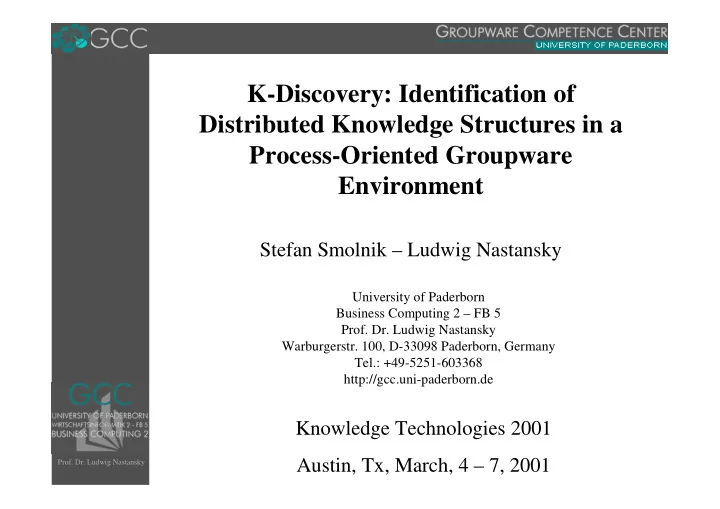

K-Discovery: Identification of Distributed Knowledge Structures in a Process-Oriented Groupware Environment Stefan Smolnik – Ludwig Nastansky University of Paderborn Business Computing 2 – FB 5 Prof. Dr. Ludwig Nastansky Warburgerstr. 100, D-33098 Paderborn, Germany Tel.: +49-5251-603368 http://gcc.uni-paderborn.de Knowledge Technologies 2001 Austin, Tx, March, 4 – 7, 2001 Prof. Dr. Ludwig Nastansky
K-Discovery @ KT2001 Overview 1. Context 2. Motivation / Small Cases 3. Using Topic Maps in Groupware-based Environments 4. The K-Discovery Architectural Model 5. Implementation Approaches 6. Conclusions
K-Discovery @ KT2001 Context � Paperless office environment / virtual communities � Office management � Computer-based teaching and learning � Coordination of projects � Workflow environments � Content management for the chair’s website “We live Groupware”
K-Discovery @ KT2001 Small Cases: NetFicient (1/3) � Groupware-based web publishing tool � Publishing of content in the organizational intranet or on the Internet � No knowledge in web programming or administration needed � Several database templates & predefined document types � Content expiry workflow & content approval process
K-Discovery @ KT2001 Small Cases: NetFicient (2/3)
K-Discovery @ KT2001 Small Cases: NetFicient (3/3)
K-Discovery @ KT2001 Small Cases: Enterprise Office (1/3) � Groupware-based and process-oriented office system � Integrated correspondence, office, document, workflow, knowledge and archive management � Process management toolset � Graphic definition, creation and maintenance of organizational structures and of business processes � Complete Internet integration � More than 15 Enterprise Office installations @ GCC
K-Discovery @ KT2001 Small Cases: Enterprise Office (2/3)
K-Discovery @ KT2001 Small Cases: Enterprise Office (3/3)
K-Discovery @ KT2001 Digression: The Design of Groupware- based Applications
K-Discovery @ KT2001 Using Topic Maps in Groupware-based Environments (1/3) � So far: weak relations between documents by using views and categories � Analysis of design elements in groupware-based applications leads to topic types and association types � Forms � Views � Building up a semantic link network from the documents by applying topic maps
K-Discovery @ KT2001 Using Topic Maps in Groupware-based Environments (2/3)
K-Discovery @ KT2001 Using Topic Maps in Groupware-based Environments (3/3) � Benefits of the groupware-based environment � Distributed database architecture and replication � Workflow management � Security and access control mechanisms � Examples: � Roles and groups: different tasks, steps and skills involved of managing topic maps can be modeled � Workflows: publishing periods and published content can be controlled
K-Discovery @ KT2001 The K-Discovery Architectural Model
K-Discovery @ KT2001 Implementation Approaches (1/6)
K-Discovery @ KT2001 Implementation Approaches (2/6)
K-Discovery @ KT2001 Implementation Approaches (3/6) � Advantages � Completely implemented in the groupware- based environment � Full groupware concepts can be applied � Disadvantages � Too many documents for the groupware-based environment � Customized LotusXSL processor
K-Discovery @ KT2001 Implementation Approaches (4/6)
K-Discovery @ KT2001 Implementation Approaches (5/6)
K-Discovery @ KT2001 Implementation Approaches (6/6) � Advantages � Groupware-based configuration and management environment � Full groupware concepts can be applied � Enhanced performance � Disadvantages � Relational repository for the objects of a topic map
K-Discovery @ KT2001 Conclusions � Substantial synergies combining groupware paradigms and topic maps � Continuing work on the second prototype � Roles and workflows � Knowledge management applications
K-Discovery @ KT2001 Questions, Remarks and Discussion � K-Discovery @ Web: http://gtm.upb.de � GCC @ Web: http://gcc.upb.de Stefan Smolnik University of Paderborn Business Computing 2 – FB 5 Prof. Dr. Ludwig Nastansky Warburgerstr. 100 D-33098 Paderborn, Germany Tel.: +49-5251-603375 Email: Stefan.Smolnik@notes.upb.de
Recommend
More recommend